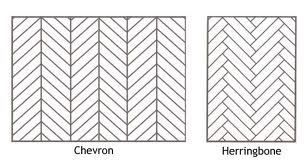When tiling a herringbone pattern standard rule of thumb is that each rectangular tile is laid at 90 degree to the tile next to it creating what the experts refer to as a fish bone pattern that also resembles a set of arrows or triangles.
Setting out herringbone wall tiles.
Herringbone slats need grooves in both ends to properly interlock.
Mix the adhesive apply adhesive to your surface lay your tiles grout and finish.
To make it easier to work out the herringbone pattern lay your tiles on the ground before gluing them to the wall.
Mark a tile using your speed square and pencil drawing a cut line from one corner at 45 degrees.
The herringbone pattern can be achieved by laying rectangular tiles or wood flooring in a pattern reminiscent of the skeleton of a herring fish.
Lay the tile along the side of the speed square to keep the tile at the correct angle.
Clamp one slat to a workbench and rout the cut end.
Lay a piece of heavy duty cardboard onto the benchtop and use the spirit level to mark the halfway point from the wall onto the cardboard.
To start place a full tile a tilted at 45 degrees against the edge or corner of the work area in our example the right bottom side.
In fabric herringbone is a distinctive v shaped weaving pattern usually found in twill fabric.
Stick it onto the wall and give it a little wiggle to make sure it s sticking.
Watch our step by step video showing how to tile a herringbone effect wall with expert advice and top tips to help you complete the job with confidence.
Use the groove of a slat to set the depth of the flooring router bit.
Previous step next step.
Dry lay the tiles.
Use your spacers to make sure the tile is.
Spread the mortar over the entire back area of the tile scrape it just like you would do the wall with the spreader at a consistent 30 45 degree angle.




























